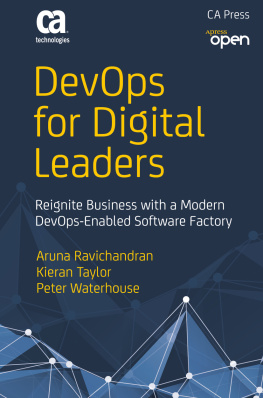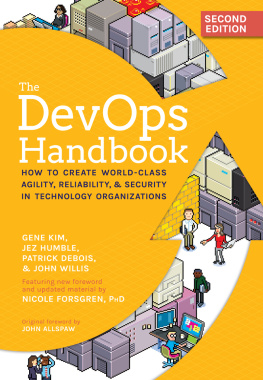Accelerating Agile Practices in Todays Software Factory
In 2016, Formula 1 (FI) racecars, the ultimate in four-wheeled technology, are awash in wireless sensors and transmitters.
Running your eyes across the graceful, sculpted bodywork of these 200+ mph engineering wonders, the only discernible interruption of their low-slung carbon fiber noses are small clusters of wireless antennas jutting up directly into the drivers sightlines.
As subtle as these transmitters may be, why would designers, who spend endless time and resources attempting to improve the aerodynamics and drivability of the machines, accept such a stark concession? The answer is simpleto arm their teams with priceless real-time data used to continuously improve performance.
Along the pit row wall, in the trackside garages, and back in the very design centers where F1 engineers continue to refine their handiwork, telemetric information provided by those tiny antennae is immediately translated into change.
While team principals and technical directors sitting directly adjacent to the track communicate directly with the drivers, advising them how to adjust settings on the fly, their colleagues in the garages prepare to adjust everything from tires to aerodynamics when the machines pull into the pits.
Meanwhile, back at the factory, live data is consumed by all manner of engineering teams who continually produce and modify new components to be utilized in subsequent competitionsbeginning the process of further advancement even before the current race is complete. The push for innovation in F1 is a perpetual activity; in this sense, perhaps more so than in any other sport, the only constant is technological change.
That Toyota Motor Corp., the global automotive giant best known for advancing such data-driven, process-centric just in time manufacturing practicesconcepts that revolutionized mass production of passenger carshad such a short-lived and disappointing record in F1 can only be classified as ironic. However, the Kanban and Kata methodologies leveraged by Toyota since its inception, paralleled on a smaller, more specialized scale by todays F1 teams, stand as the most widely emulated management frameworks in history.
With an emphasis on the adoption and evolution of processes designed to optimize resources while increasing production speed and qualityand most importantly promoting constant innovationthe Toyota Way represents arguably the leading model for continuous improvement.
In the words of W. Edwards Demingthe legendary American engineer and management consultant who helped spearhead the reinvention of Japanese industry after WW2Toyotas approach embodies the notion that, It is not enough to do your best; you must know what to do, and then do your best.
Grounded in constant observation and measurement of efficiencyfrom supply chain management through final production, with the goal of constantly improving output, including and in particular worker productivitythis methodology flies in the face of traditional waterfall workflows. American automaker Henry Ford may be credited with revolutionizing the assembly line, but Toyota is widely recognized for decoupling and perfecting it.
Rather than creating linear dependencies, where each successive activity is wholly dependent on completion of the task preceding it, this revolutionary approach emphasizes techniques wherein production is dynamically adapted on the fly to result in optimal efficiency and maximum quality.
Further illustrating the staunch devotion to continuous improvement represented both in the Toyota Way and in his personal doctrine, Deming famously said, It is not necessary to change. Survival is not mandatory.
This observation is neither subtle, nor, given industrial history, seemingly misplaced.
Embracing DevOps in the Application Economy
In todays rapidly evolving Application Economy, it is widely recognized that, driven by the evolution of digital channelsacross both the business-to-business and consumer segmentsmany organizations are reinventing or recasting themselves as providers of software and digital services.
For example, the global population of mobile banking users is forecast to double to 1.8 billion by 2020, representing over 25 percent of the worlds population, according to KPMG. As a result, banks are increasingly focused on advancement of web-based and mobile applications, versus expansion of brick-and-mortar operations.
Furthermore, as business delivery mechanisms shift to the digital landscape, end users tolerance of latency of such applications has grown increasingly narrow. According to a study published by Wired in June 2014, roughly 50 percent of consumers expect a web page to load in two seconds or lessor they move to abandon it.
Given this transformation, as traditional business services are replaced by largely web-based and mobile-friendly applications, organizations are being forced to completely reexamine their software development and IT management practices. Technology is no longer viewed as a supporting dependency, but rather as a primary element of conducting business.
Within that context, most of todays organizations are moving aggressively to adopt more agile, efficient software delivery and IT management practices to meet customers evolving expectations. Among the fastest growing and most widely adopted strategies, aimed at bringing Toyota-like efficiency to the world of the applications lifecycle, is the methodology known as DevOps .
Whether or not Patrick Debois understood that he was creating, or at the very least putting a name to, the movement that would completely redefine the manner in which organizations build and support software is unclear. What is known is that since Debois, a systems administrator, and a handful of like-minded software development and IT operations experts first coined the DevOps moniker in 2009, the concept has become a global phenomenon.
The underlying concepts encompassed by DevOps are, at first glance, straightforward, but represent seismic reformulation within the context of software production and support. Rather than maintaining discreet applications engineering (Dev) and IT management (Ops) competencies and organizations, DevOps dictates use of smaller teams with cross-functional expertise to improve software functionality and the processes used to deliver it.
As highlighted in the seminal DevOps novel, The Phoenix Project , this mindset eliminates the fragmented approach to applications delivery that has traditionally crippled many organizations in addressing the digital market opportunity. Rather than asking developers to build an application and then charging IT management with ongoing support, creating highly disparate and inefficient dynamics, DevOps brings those specialists together so that engineering is completed with a constant eye toward ongoing management.
Just as critical in boosting organizational efficiency and software quality, DevOps methodologylike the Toyota Wayalso promises to increase the ability to change the existing code base and deliver new capabilities to end users, while cultivating internal experimentation. Leveraging automation to do so is another hallmark of the Japanese carmakers model and is also core to the DevOps approach.













